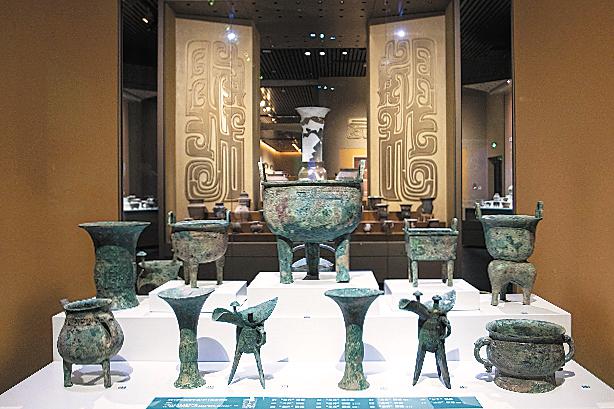New museum to display best of Shang civilization


A new museum will soon open in Anyang, Henan province, to display the brilliance of the 3,000-year-old Shang civilization, the National Cultural Heritage Administration announced at a news conference in Beijing on Feb 19.
The Yinxu Museum, which will open to public on Feb 26, is China's first comprehensive archaeology museum that will unveil the panorama of the Shang Dynasty (c.16th to 11th century BC).
Online reservation for the new museum will open on Feb 22 through its official website ayyx.com.
Nearly 4,000 unearthed cultural relics, including bronze wares, pieces of pottery, jade artifacts and oracle bones will be displayed in the museum. More than three quarters of these have never been publicly exhibited before.
The Yinxu Ruins, listed as a UNESCO World Heritage Site in 2006, hosted a later period Shang capital city. First excavated in 1928, Yinxu has also been the longest studied ancient capital city ruins in China, and is thus honored as one of the cradles of modern Chinese archaeology.
The site also yielded rich findings of 3,300-year-old oracle bones — the inscribed animal bones and tortoise shells used for fortunetelling and recording events — revealing the oldest-known established writing system of Chinese characters.
When visiting the Yinxu Ruins in October 2022, President Xi Jinping pointed out that the Chinese characters are extraordinary and serve as a vital link in the development of the Chinese nation. He then urged attaching more importance to and putting more efforts into archaeological research to carry forward the project of tracing the origins of the Chinese civilization.
According to Yan Yalin, director of the archaeology department at the National Cultural Heritage Administration, many key archaeological breakthroughs were made in recent years at the Yinxu site and its surrounding areas.
For example, an urban road system and the remains of an artificial lake in the royal ancestral temple area were found. The oldest confirmed mausoleum of Shang kings was also found.
"Discoveries of many satellite settlements and large-size handicraft workshops around this metropolis further portrayed a grand picture of a capital city," Yan said.
The 23 chariots unearthed from Yinxu will be the highlights in the new galleries. Legendary Shang general Ya Zhang's life will be reflected through a whole set of objects excavated from his tomb.
Also on display will be Shang relics collected from across the rest of present-day China.
"Through the exhibits, the public can better view the new findings and comprehensively understand the achievements made by the Shang Dynasty in terms of politics, economy, agriculture, military affairs, among others," Yan added.
More technical platforms will be set up to create a hub for digitized material on unearthed relics and related documentation, he said.
Over 90 percent of the exhibits were excavated by generations of researchers from the Institute of Archaeology at the Chinese Academy of Social Sciences since 1950. Chen Xingcan, head of the institute, will be director of the new museum.
"With the new facility, we'll accelerate our improvement of relic preservation and have better equipment for detailed archaeological research," Chen said. "Opening of the museum marks the start of a much longer journey."
The original building of the Yinxu Museum opened in 2005 as an important step in the process of bidding for a World Heritage Site status. However, its 1,500-square-meter exhibition space was way too small, said Gao Yong, mayor of Anyang, at the news conference.
The project to build another venue was thus launched in 2020. The new museum, built at a cost of 106 million yuan ($14.7 million), is located across the river from the palace and temple area of the Yinxu Ruins. It covers 17.5 hectares with an exhibition space of 22,000 sq m, Gao said.
He Jingtang, an academician at the Chinese Academy of Engineering and a professor at South China University of Technology, is the chief architect of the new venue. His design blueprint was inspired by ancient poems on Shang and exquisite bronze wares from that dynasty.
Scholars from renowned institutions at home and abroad jointly contributed to establishing the new museum, including Peking University, Fudan University, the British Museum, the Metropolitan Museum of Art, Freer Gallery of Art, University of British Columbia, among others.
"With this new platform, we can organize more international academic programs centering on Shang studies to better reflect the key role of Yinxu in the development of world civilization," Gao said.







